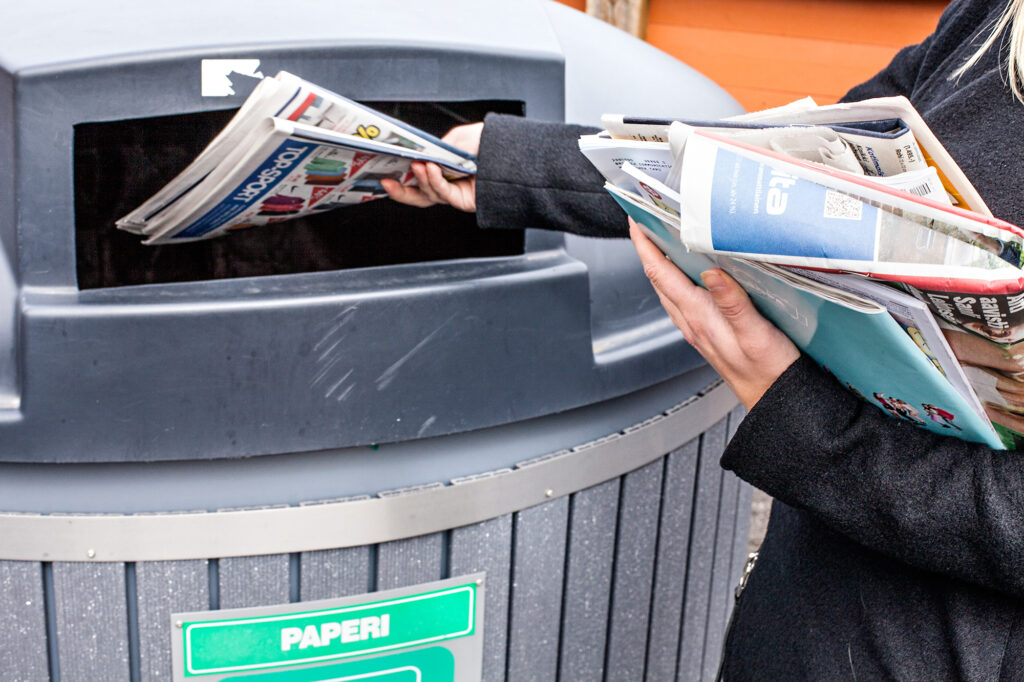Finnish mills face shortage of recycled fibre

Reduced paper consumption means diminished flows of recycled fibre, too. Unacceptable material among the recycled paper from households cause more and more problems.
Paperinkeräys Oy is a company with tangible experiences of the reduction in paper consumption. Some decades ago, all of the company’s turnover was derived from managing recycled paper. Since the 1990’s, the company has added new services to compensate for the decline in the recycled paper business.
”Currently only half of our turnover comes from recycled fibre. After 2008–09, the amount of graphic paper collected has declined by 10 percent per year, in some grades by as much as 40 percent”, says company CEO, Mr Kyösti Pöyry.
Pöyry points out that the paperless office has been under discussion since the 1950’s. In the beginning, progress towards a paperless environment was slow, but the pace is obviously picking up now.
”We have combated the decline by first starting to collect cardboard packages and then plastic, metal, glass, electronic appliances and wooden pallets. We are currently a full-blooded waste management provider.”

Demand exceeds supply
The collection volumes of recycled paper in Finland grew rapidly until 2008. Then, the economic downturn began to interfere with paper consumption and digital media captured the market.
Paper was no longer produced in the same amounts. The circulations of newspapers and magazines declined. The number of pages in publications dropped, and many newspapers switched to smaller, tabloid-sized paper. As the amount of paper available was less than before, it was not possible to collect the same quantities either.
Currently, the mills using recycled paper are forced to adapt to the scarce supply. “Industry could indeed use more recycled paper”, says Mr Iiro Mattila, Purchasing Manager at the Mänttä mill of Metsä Tissue.
The Mänttä mill produces tissue and cooking papers and is one of the ten or so mills in Finland that use recycled paper as raw material. Here, too, there’s a demand for bigger quantities of recycled paper.
If faced with a shortage of recycled fibre, the mill may have to consider switching to other products.
Recycled fibre is also profitable for the industry because it is clearly less expensive a raw material than primary fibre. “For many of our products, we can use both primary and recycled fibre. However, product recipes cannot be changed in an instant, and the share of recycled fibre in the final product is determined by its quality requirements. If it seems that we are about to face difficult times, we will put our buyers to work, so as to obtain the raw material required”, says Mr Tero Alvoittu, Quality and Environmental Manager at the Mänttä mill.
Everything but the kitchen sink

Parallel to the decrease in volume, the quality of recycled paper received at Mänttä has also deteriorated. This is partly due to changes in the shares of different paper grades: high-quality office and magazine papers are less important on the market and the share of newsprint is growing.
But Mattila and Alvoittu have also observed another change. “We used to get the best quality from the best suppliers. Now we are looking at everything on the market that we can get. As a result, there are even bicycle frames and garden furniture among the paper”, Alvoittu says about the recycled paper collected from households.
Is this because the consumers are behaving in a different way? A direct answer is not forthcoming, but the question continues to puzzle. “When the volume of the recycled paper declines, quality disturbances become more important,” says Alvoittu.
The pile of waste separated from the paper flow is a sorry sight. “At one glance, you can see several soccer balls, hundreds of plastic bottles and CDs, just to take a few examples” says Alvoittu.
Amount of junk reflects strength of recycling motivation
On the other hand, there’s no longer enough time to sort out the reject material. “It takes time to spread a large, 35-ton load of paper into a layer thin enough to be picked over by hand,” says Mattila.
Mattila and Alvoittu admit that their faith in the recycling motivation of Finnish consumers is being tested. In the worst case, the whole paper load has to go to waste if sorting it proves to be too much work.
“The junk found among the paper loads indicates how some consumers view recycling. Whether it’s ignorance or indifference, I don’t know,” Alvoittu says.
The Finns have, however, learned to put their paper in the recycling bin. In 2013, the paper recovery rate in Finland climbed up to a new record level. 80 percent of the paper and board consumed in Finland ended up being recycled, as against the European average of 72 percent.
Recycled paper looks for export markets, too
Recycled paper is mainly used to produce new paper and packaging material. More than half of the recycled paper processed in Finland ends up as new paper products. The UPM Kaipola mill, the only producer of newsprint in Finland, is the biggest single user of recycled fibre.
Recycled paper also moves across borders. About one-fifth of the paper and cardboard collected in Finland is exported. On the other hand, some is also imported to Finland.
The CEO of Paperinkeräys says that recycled paper is like any other commodity that seeks the best price on the market. The company has delivered batches of recycled paper to such faraway destinations as China and Indonesia.
Contracts can be made for very small batches. “For example, small and specialized mills operate in Central Europe as well as in Asia. The paper is shipped in containers like any other commodity.”
Although the amounts have gone down, paper products made of recycled fibre are not about to vanish from the Finnish market. “Products made of recycled paper will be available in the future,” says Alvoittu and points out that some consumers specifically want products made from recycled fibre.
Whether the product includes recycled fibre or not, the positive image of recycled paper is deeply embedded in the mind of the Finnish consumer. “Consumers consider greyish paper more environmentally friendly,” says Alvoittu.

Kirjoita kommentti